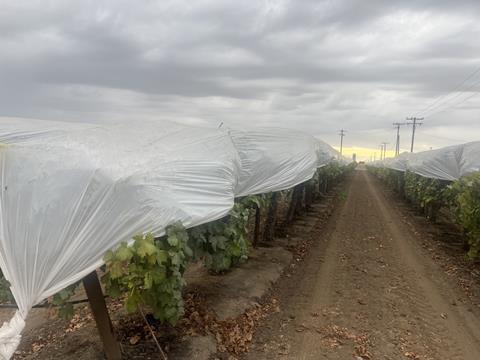High-quality season comes to a close as growers contend with storm damage and pricing struggles
As of mid-October, the 2025 California table grape season entered its final weeks of harvesting, with a mixed bag of results. By most accounts, fruit quality has been quite strong with respect to sizing, appearance and taste due in large part to a relatively mild summer in the San Joaquin Valley. With the exception of a few weeks in August, daytime temperatures typically topped out at around 35°C (95°F), which is basically ideal for good-quality grapes.

However, Mother Nature decided to toss a late-season twist into things in the form of a vigorous rainstorm that struck the valley on 14 and 15 October. According to reports, between 20 to 30mm of precipitation fell on the heart of the grape-growing area between Bakersfield and Visalia, sending growers to hastily cover their vines to minimise any fruit damage.
“Virtually all vineyards have plastic covering ready to be pulled on in case of rain,” noted John Pandol of Pandol Bros. “This was an unusually strong storm for October, but it shouldn’t be an issue for most growers.” Not all were in agreement, however.
“Driving around, I saw many vineyards that didn’t get covered,” said one major exporter who asked not to be identified. “Those that did could still see their fruit get hit by disease from moisture coming back up from the ground. We will have to wait to see what the next few weeks bring.”
The storm reportedly prompted some shippers to halt all ocean exports to Asian markets out of concern for bad arrivals.
“We’re probably going to stop sea shipments from here on and stick to just air shipments because we don’t want to take on the risk,” said the exporter.
The other challenge California growers have been grappling with this season is low prices.
“The market hasn’t been as good as we would have wished,” admitted Pandol. “There have been many sales below the break-even level. The deal this year started pretty slowly, competing with summer fruit, especially cherries. It was a struggle at first to move inventories and keep up with the harvest. But shipments picked up pace in the late summer to early fall allowing inventories to get back in balance.”
According to the USDA, the California industry had about 6 per cent more inventory in cold storage at the end of September than it did at the same period in 2024 (10.8mn cartons vs. 10.2mn), largely due to lagging demand for red grapes. However, two of the major late season varietals, Autumn King and Scarlet Royal, were reported to have less stocks on hand than a year ago.
How growers decide to manage their inventories for the remainder of the season remains to be seen. Some may elect to keep pre-rain fruit on hand while moving potentially suspect product quickly into distribution.






